The freedom of association is as imperative to a free America as ever. The great French thinker Alexis de Tocqueville admired this country’s “science of association”—the exceptional American habit of citizens coming together to solve common problems. Today, many disenfranchised Americans want to win back the cultural consensus on civics education. Heritage Foundation research, data, and analysis have identified that parents are willing to help to improve the quality of civics education that their children receive, and to foster an appreciation for the nation’s founding principles, enshrined in the Declaration of Independence and the Constitution.
Focusing on the pursuit of the truth in civics education, and building a coalition of informed and involved parents, offer a very fruitful road map to a flourishing civil society for all Americans. Students must learn the truth about America’s heritage—its imperfections as well as its remarkable strengths. Every American child should inherit an appreciation for the nation’s concepts of freedom and virtue, study the architects and practice of self-government, and understand why they themselves carry responsibility to uphold the benefits and responsibilities of citizenship.
Today, however, critical race theory (CRT), which makes race the prism through which its proponents analyze all aspects of American life, has made its way into classrooms across the country. CRT underpins identity politics, driving decision-making according to skin color—not individual merit and talent. CRT teaches young minds to see the world as divided into two categories, oppressors and their victims, weakening public and private bonds that create trust and allow civic engagement.
These teachings are reversing the immense progress this country has made in race relations and equality, as well as stealing major parts of history from students, beginning with small children. Young Americans are taught not to be proud of their country, but to see it as an oppressor. In order to reverse this destructive and dangerous trend, it is essential that schools teach America’s founding principles, while at the same time build strong relationships between parents and teachers.
Two studies (one of parents, one of teachers) commissioned by Heritage’s Edwin J. Feulner InstituteREF suggest that the core tenets of a renaissance in civics education must include building active parent coalitions that give parents, students, and teachers the framework to fight back against politicized and ideological teachings, thereby mitigating the risk of backlash against students who voice their independent and critical thinking, rejecting partisan politics, and providing transparency in curricula.
Recommendations for State Policymakers
To provide parents and teachers with more and better civics education, schools should promote civic knowledge. The Feulner Institute survey revealed that two-thirds of parents and nearly three-quarters of teachers share a strong desire to see greater emphasis on civics education. Indeed, interest in civics education among parents has increased substantially over the past five years. However, only around one-third of each group are satisfied with the type of content included in their schools’ civics education. In order to improve civics education and meet the needs of families, there are specific actions that states should take. State policymakers should:
Direct School Districts to Use Civics and History Materials that Teach Students the Duties of Informed Citizenship. Parents and teachers believe that students benefit from civics education that teaches them the core functions of government. Both parents and teachers agree that the most important function of civics in modern-day America is “practical information and guidance on how to carry out the duties of a citizen.” Both groups also agree that civics curricula should focus primarily on “the rights and duties of citizenship” rather than on critical race theory—the ideology that teaches that people are either oppressed or oppressors—based on the color of their skin.
Yet, many school districts across the country have de-emphasized traditional civics education and are focusing instead on “anti-bias” training and “diversity” training. School districts should encourage schools and educators to focus on teaching traditional civics content that equips students with the tools they need for meaningful civic engagement after school. Rigorous civics materials have been produced by organizations such as 1776 Unites, the Institute for Classical Education, the Jack Miller Center, the Bill of Rights Institute, and the Ashbrook Center, with this goal in mind. As explained in a recent Heritage Issue Brief, “This material recognizes the importance of facts and acknowledges the periods in history when Americans failed to live up to their ideals while not allowing these periods to eclipse the national character and culture of freedom and equality under the law.”REF
Prohibit the Application of Critical Race Theory in Public Schools. The application of CRT in the classroom violates federal civil rights laws:
No law should bar schools from teaching what Critical Race Theory is, but schools do violate existing civil rights laws when they operationalize Critical Race Theory in ways that treat students differently because of their skin color, national origin, or sex, or claim that children are guilty of oppression because of these immutable characteristics. Such applications violate existing law, such as Title VI of the Civil Rights Act,
as Heritage analysts Lindsey M. Burke, Jonathan Butcher, and Mike Gonzalez recently explained in a public comment they submitted on a proposed federal rule pertaining to CRT.REF State policymakers should make it a point to protect free speech rights, while following the lead of states like Idaho, which recently approved a law protecting children from CRT. The law does not ban schools from teaching what CRT is, but prohibits schools from forcing students to affirm, adopt, or adhere to CRT through compelled speech and other practices.
Allow Alternative Teacher Certification. Approximately 90 percent of public school teachers have a state teaching license, an estimated 70 percent of whom obtained it through a college of education.REF CRT and its perversion of history permeates these colleges of education—the training grounds for the hundreds of thousands of teachers who enter the pre-K–12 classroom every year. Aspiring teachers should not have to accept training in CRT. States should end requirements that teachers be state certified, significantly reducing enrollment in colleges of education, while allowing alternative teacher certification that takes place outside these colleges.
Require Public Schools to Make Pre-K–12 Materials Publicly Available. Parents value and want curriculum transparency. Although just one-third (35.6 percent) of parents said that their children’s school is “very transparent” in conveying its educational philosophy and curriculum content, 62.8 percent of parents said that transparency is important to them (36.9 percent said that it was “very important”). In order to fulfill the desire of parents to have easy access to the content being taught in their children’s schools, states should require public school districts to put course syllabi, titles of assigned books and articles, and class assignments online. Utah and Arizona recently adopted proposals along those lines that provide models for other states.
Create and Expand Education Freedom. School choice is a critical component of restoring civics education. One of the most important tools for combatting CRT in the classroom is giving parents control of where, and what, their children learn. Indeed, as the Feulner Institute survey demonstrated, parents of children who attend private school are the most satisfied (68 percent) with the type of civics content taught at their schools. States should follow the lead of Arizona, Florida, Indiana, Mississippi, North Carolina, Tennessee, and West Virginia and provide education savings accounts (ESAs) to parents, enabling them to pay for private schools and education options of choice. States provide a portion of the money that would have been spent on a child in public school directly to parents in the form of a restricted-use ESA. Parents can then use those funds to pay for any education-related service, product, or provider of choice, including private school tuition, online learning, special education services and therapies, private tutors, and a host of other education supports.
Enabling parents to direct where their children’s portion of education funding is spent not only allows them to match their children with schools that are the right fit, but holds all schools accountable by allowing parents to take their funds elsewhere if a particular school does not meet their child’s needs. Such accountability is a key tool in making certain that schools are responsive to parents who demand quality civics education.
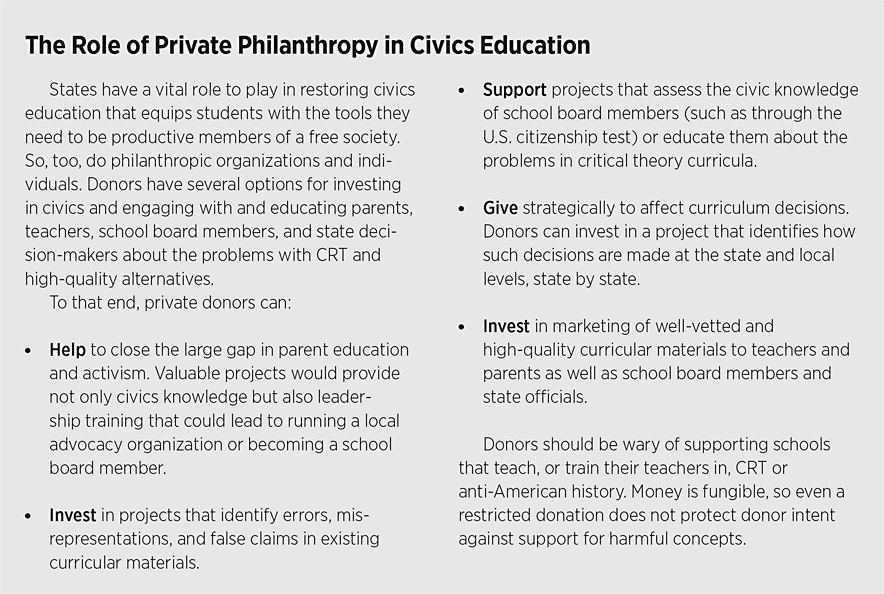
Conclusion
The pursuit of truth is the greatest hope for a return to a trustworthy and genuine liberal education for all Americans. “For no people will tamely surrender their Liberties, nor can any be easily subdued, when knowledge is diffused and Virtue is preserved,” Samuel Adams wrote in 1775. The cornerstone for educating the next generation includes the transfer of knowledge, skills, and habits that develop responsible citizens: self-governing citizens who can thrive in a democratic republic.
Teachers and parents must work together to protect children from the forced indoctrination of ideology and political activism. Such practices threaten everyone’s freedom and liberties. President Ronald Reagan’s words ring true today:
Freedom is never more than one generation away from extinction. We didn’t pass it to our children in the bloodstream. It must be fought for, protected, and handed on for them to do the same, or one day we will spend our sunset years telling our children and our children’s children what it was once like in the United States where men were free.
Americans should recommit themselves to the teaching of civics in the classroom and at home. As students understand how the past connects to the present, they will come to safeguard the sanctity of the American idea and appreciate the validity and relevance of those ideals to all Americans, especially to those who have lost confidence that their nation is a place of hope, opportunity, and community for all.
Angela Sailor is Vice President of the Edwin J. Feulner Institute, at The Heritage Foundation. Lindsey M. Burke, PhD, is Director of the Center for Education Policy and Mark A. Kolokotrones Fellow in Education, of the Institute for Family, Community, and Opportunity, at The Heritage Foundation. Anne Segal is the founder of The Frontier Lab. Adam Kissel is Senior Fellow at the Cardinal Institute for West Virginia Policy.
Appendix: Survey Results: Opinions of Parents and Teachers on Civics Education
1. Introduction to Opinions on Civics Education and Critical Race Theory
The Feulner Institute examined survey responses of 1,003 teachers and 1,012 parents regarding the purpose and content of civics education. Two-thirds of parents and nearly three-quarters of teachers share a strong desire to see greater emphasis on civics education. However, only around one-third of each group are satisfied with the type of content in civics education at their children’s schools.
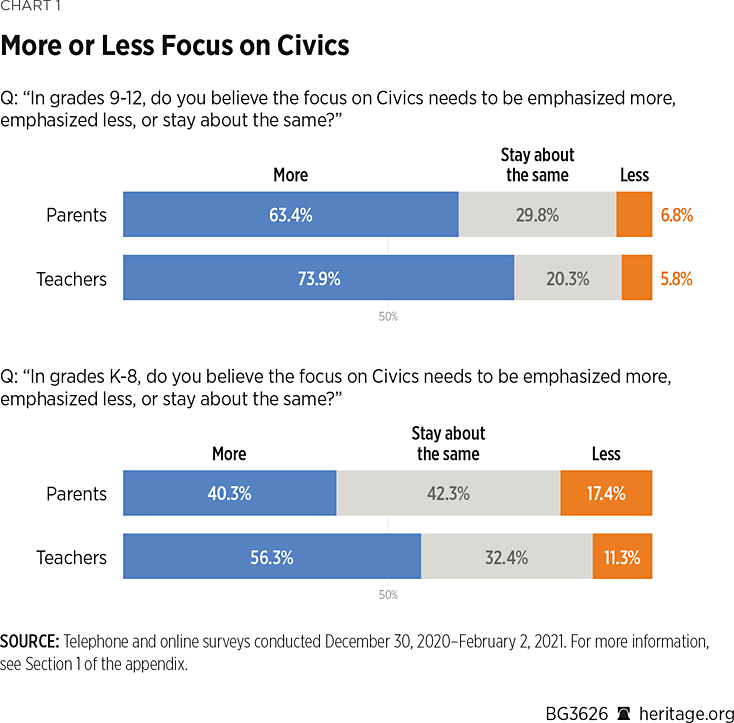
- 63.4 percent of parents and 73.9 percent of teachers say that civics education should be emphasized more in grades nine through 12.
- 40.3 percent of parents and 56.3 percent of teachers say that civics education should be emphasized more from kindergarten to grade eight.
- 38.1 percent of parents and 31.5 percent of teachers are satisfied with the type of content included in their schools’ civics education.
Further examination of how survey participants responded to questions about content indicates that some differences exist not only between parents’ and teachers’ opinions, but, notably, among opinions of parents of varying education levels.
Study 1: Method. For Study 1 of the “Civics Survey of Parents and Teachers,” questioners interviewed adults 18+ who are parents of school-age children (pre-K–12) in the United States. Braun Research, Incorporated conducted a total of 1,012 parent interviews online from December 30, 2020, through February 2, 2021. The margin of sampling error for this study is +/– 3.08 percent (95 percent confidence level).
Study 2: Method. For Study 2 of the “Civics Survey of Parents and Teachers,” questioners interviewed teachers for grades pre-K–12 in the United States. Braun Research conducted a total of 1,003 teacher interviews online and by phone from December 30, 2020, through February 2, 2021. The margin of sampling error for this study is +/– 3.09 percent (95 percent confidence level). The teachers sample consists of 84.3 percent public school teachers, 11.2 percent private school teachers, and 4.6 percent charter school teachers.
2. Demand for, and Purpose of, Civics Education Today
Civics education is prioritized by both parents and teachers today in the education of children of all ages. This demand focuses more strongly on the upper grades (nine through 12) but remains strong even for the pre-K–8 years. However, teachers reported a greater interest in more K–8 civics education than did parents by almost 14 percentage points. There is greater new interest in civics education among those who identify as Democrats, the most highly educated parents, and parents of private school students than among their counterparts.
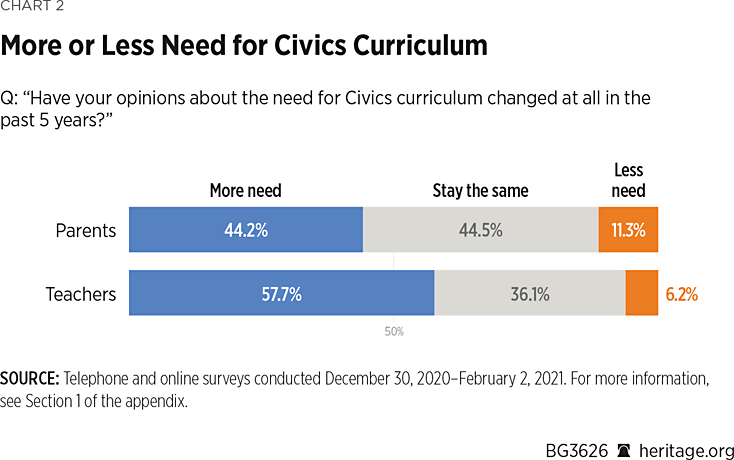
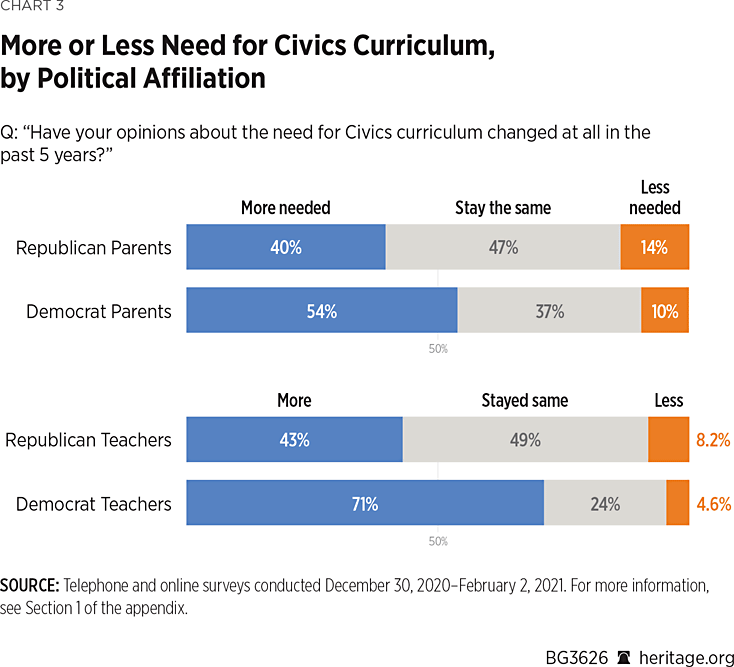
Parents and teachers also said that students are more engaged in the classroom on civics-related topics than on other topics—yet parents and teachers also believe that the classroom is more divided and less civil than in the past.
- 30.8 percent of parents said that students are becoming more divided on civics topics, 23.3 percent said that students are more united, 25.7 percent said that things are about the same, and 20.2 percent are unsure.
- 38.6 percent of teachers said that students are becoming more divided on civics topics, 23.1 percent said more united, 25.7 percent said about the same, and 12.6 percent are unsure.
- 33.9 percent of parents said the classroom atmosphere is less civil, 25.9 percent said more civil, 26.2 percent said about the same, and 14.0 percent are unsure.
- 38.1 percent of teachers said the classroom atmosphere is less civil, 24.3 percent said more civil, 31.0 percent said about the same, and 6.6 percent are unsure.
There is also more discussion in the classroom than in years past as well as more interest in civic engagement on the part of students.
- 31.9 percent of parents and 41.7 percent of teachers said students are more engaged.
- 36.0 percent of parents and 54.6 percent of teachers indicated there is more discussion than in years past.
- 37.6 percent of parents and 50.4 percent of teachers said there is more interest in civic engagement than in years past.
Current attitudes about the purpose of civics education show initial uniformity, but also a critical difference between parents and teachers. While both groups agreed that the most important function of civics in modern-day America is “practical information and guidance on how to carry out the duties of a citizen,” they did not agree on the next most important function: 25.1 percent of parents said that the second most important function is to “ensure we are a united America going forward,” while only 16.0 percent of teachers agreed. Teachers placed greater emphasis on “expose students to varying viewpoints about America.”
Finally, 79.3 percent of parents and 74.4 percent of teachers said that they would be open to spending more time with their children/students to ensure that they receive a civics education.
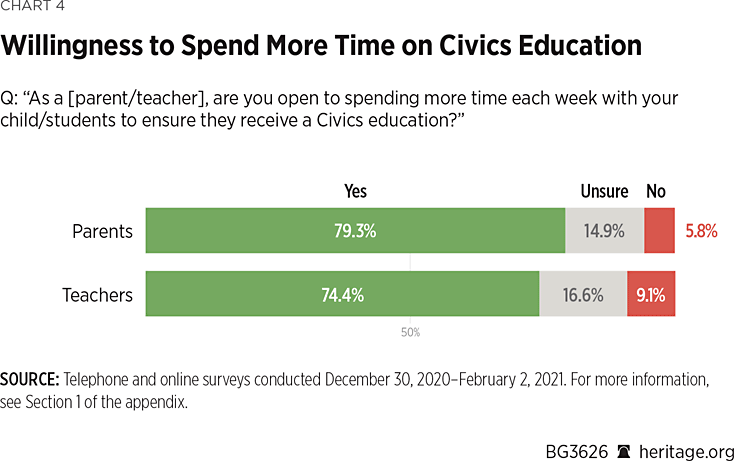
There is both demand and opportunity for civics education with supportive parents and teachers, and energized students—against a backdrop of a more contentious and livelier classroom context.
Satisfaction with Civics Content. Pluralities of both parents and teachers are neutral about the type of content of civics education—but the differences in parents’ race or education level revealed groups with greater satisfaction. Overall, about one-third (38.1 percent of parents and 31.5 percent of teachers) are satisfied with the type of content included in their school’s civics education curriculum, but pluralities of both groups are neutral: 43.5 percent of parents and 46 percent of teachers. While 17.6 percent of parents and 13.3 percent of teachers are “very satisfied”—that is, scoring their satisfaction as 7 on a scale of 1 to 7—another 20.5 percent of parents and 18.3 percent of teachers provided scores of 6.
Satisfaction with the type of civics education content varied according to parents’ race, with both white and Hispanic parents predominately neutral, and black parents the only racial group that was predominately satisfied. Hispanic parents are less likely than black or white parents to be satisfied—and black parents were the most likely to be “very satisfied.”
- 25 percent of black parents are “very satisfied” (score of 7) vs. 17 percent of white parents and 13 percent of Hispanic parents.
- 55 percent of black parents are “satisfied” (score of 6 or 7) vs. 36 percent of white parents and 30 percent of Hispanic parents.
- Hispanic (51 percent) and white (45 percent) parents are predominately neutral about the type of content; only black parents are majority satisfied.
The most educated parents showed greater support than other education levels for the type of civics content in their school: 58 percent of parents with a post-graduate degree were satisfied with the type of civics content currently taught in their children’s schools compared with 45 percent of those parents with a college degree and 35 percent of those parents with a high school diploma or less.
Other differences in satisfaction with civics curriculum content include political party (Democrats are 15.6 percentage points more satisfied than Republicans), regional area (Midwesterners are least likely to be satisfied), and the type of school children attend. Parents of children who attend private school are the most satisfied (68 percent) with the type of civics content.
- Democratic parents: 49 percent satisfied.
- Republican parents: 33 percent satisfied.
- Charter school parents: 55 percent satisfied.
- Homeschooling parents: 41 percent satisfied.
- Private school parents: 68 percent satisfied.
- Public school parents: 34 percent satisfied.
- Midwesterners are least likely to be satisfied with the type of content, compared to other regions.
The Elements of an Ideal Civics Education. The surveys also asked parents and teachers about the elements of an ideal civics education in two ways: First, asking which topics should be the focus, and second, asking participants to respond to a series of elements with the degree to which they believed each element should be included in a civics curriculum.
First, regarding the topics that should be the focus of a civics curriculum, the majority of parents (68.1 percent) and of teachers (82.7 percent) selected “the study of the rights and duties of citizenship” as the primary focus. Of the provided options, parents (34.0 percent) and teachers (41.3 percent) were also both least likely to select “Critical Race Theory.”
Teachers (63.4 percent) are more likely than parents (41.8 percent) to prioritize primary sources over secondary sources and supplementary research.
Classroom Time for Civics Content. Pluralities of both parents and teachers are neutral about both the amount of time spent and the type of civics content. However, satisfaction with the amount of time spent on civics education varies depending on race. While 21.3 percent of all parents are “very satisfied” with the amount of time spent on civics education, this number increases to 37 percent for black parents (20 percent of white parents and 18 percent of Hispanic parents are “very satisfied”).

Only about one-third (35.6 percent) of parents said that their children’s school is “very transparent” in conveying its educational philosophy and curriculum content, whereas 44.8 percent of teachers said that of their school—a difference of more than nine percentage points. Parents of children in private schools were much more likely to view their school as “very transparent” (66 percent) compared with parents of children in public schools (30 percent). At the same time, parents said that transparency is important (62.8 percent) to them, including the 36.9 percent who said it was “very important.”
3. Special Topic: Critical Race Theory
Critical Race Theory (CRT). Fewer than four in 10 parents are familiar with CRT, and teachers were more likely to be familiar with the term than parents. Of those parents who are familiar with CRT, only half have a positive view of it.
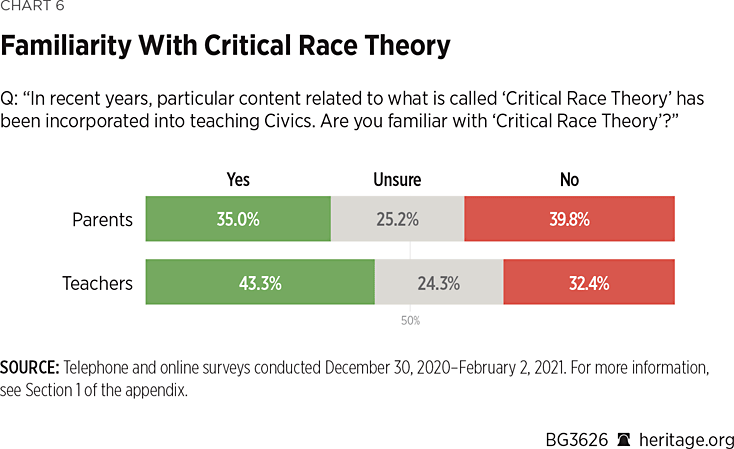
- One-third of parents (35.0 percent) said they are familiar with CRT.
- 43.3 percent of teachers said they are familiar.
- A plurality of parents (39.8 percent) said they are unfamiliar, and 25 percent were unsure.
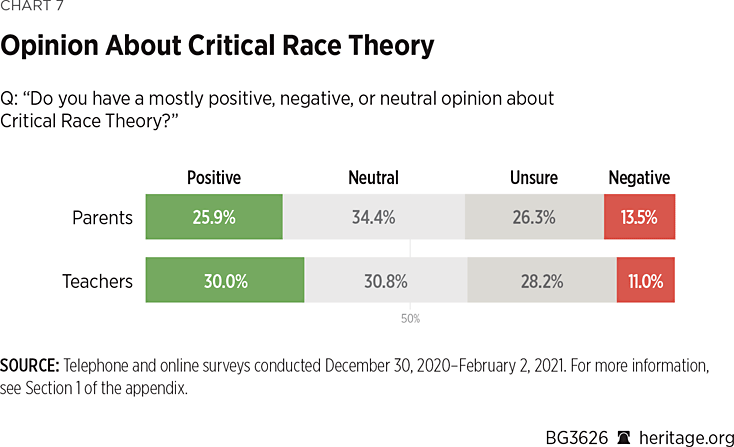
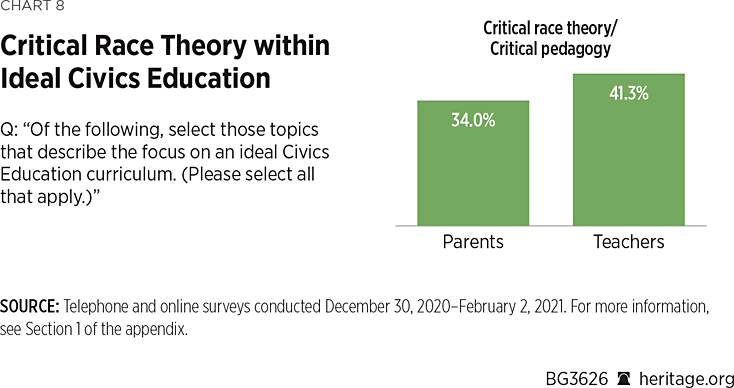
While six in 10 parents are neutral or unsure about CRT, 34 percent of parents (and 41.3 percent of teachers) support focusing civics education on CRT; 28.6 percent of Republican parents selected CRT, compared to 43.6 percent of Democratic parents, and those parents in the Western U.S. are most likely to have selected it as a focus compared to other regions (42.9 percent). Parents of public school children were less likely (34.7 percent) to have selected the focus of CRT than either charter school (48.7 percent) or private school (43.9 percent); homeschooling parents were least likely (26.3 percent) to select it.
When asked the degree to which CRT should be included in a civics curriculum rather than whether it should be a focus, half of parents (49.9 percent) and an even greater percentage of teachers (57.5 percent) said it should be included (providing scores of 6 or 7 on a 7-point scale).
Parents’ lack of familiarity with the term “Critical Race Theory” (only 35 percent of parents are familiar) combined with the willingness to select it as a focus (34 percent) and to deem it relevant (49.9 percent) suggests that this support could be based on other factors, perhaps a spirit of inclusiveness despite not knowing what the term means.
Gender Roles. 50.6 percent of parents said that gender roles are overall relevant (a score of 6 or 7 out of 7) to a civics curriculum, about nine percentage points lower than teachers, 59.5 percent of whom said the topic is relevant.
Social Causes. The majority (58.4 percent) of parents are supportive of high school students participating in advocacy efforts for social causes; 25.5 percent are neutral. Those parents at the post-graduate level of education were the most supportive (74 percent). In addition, there was variation according to race: 72 percent of black parents are supportive, compared to 58 percent of Hispanic parents and 56 percent of white parents.
Other Topics
The Founding Era. Close to six in 10 (56 percent) parents think that “Philosophies leading to the Constitution and Founding Era” are relevant topics for a civics curriculum. Of all racial groups, Hispanics were least likely to support this focus as being “highly relevant”: 20 percent of Hispanic parents said it is highly relevant compared to 32 percent of black parents and 31 percent of white parents.
A similar percentage of teachers (59.5 percent) agree that “Philosophies leading to the Constitution and Founding Era” are relevant topics for a civics curriculum. The greatest difference between parents and teachers becomes apparent when examining the breakdown by racial group. While white parents and teachers, and black parents and teachers, hold similar opinions, there was a much greater difference between Hispanic parents and teachers, and between non-white parents and teachers: 19.5 percent of Hispanic parents who support this topic’s inclusion in civics curriculum increases to 41.7 percent of teachers, while 29.8 percent of non-white parents increases to 36.7 percent of non-white teachers.
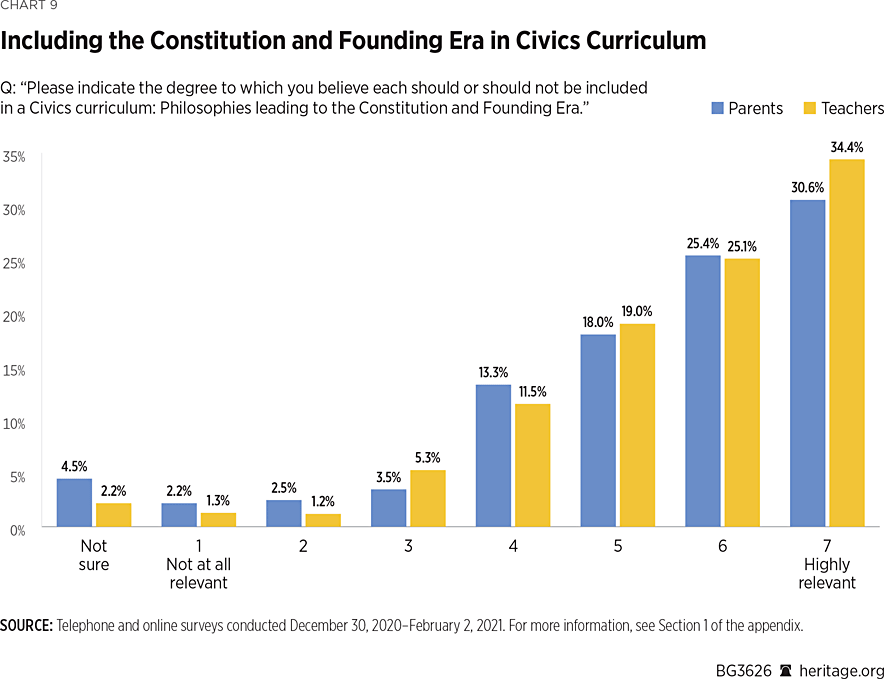

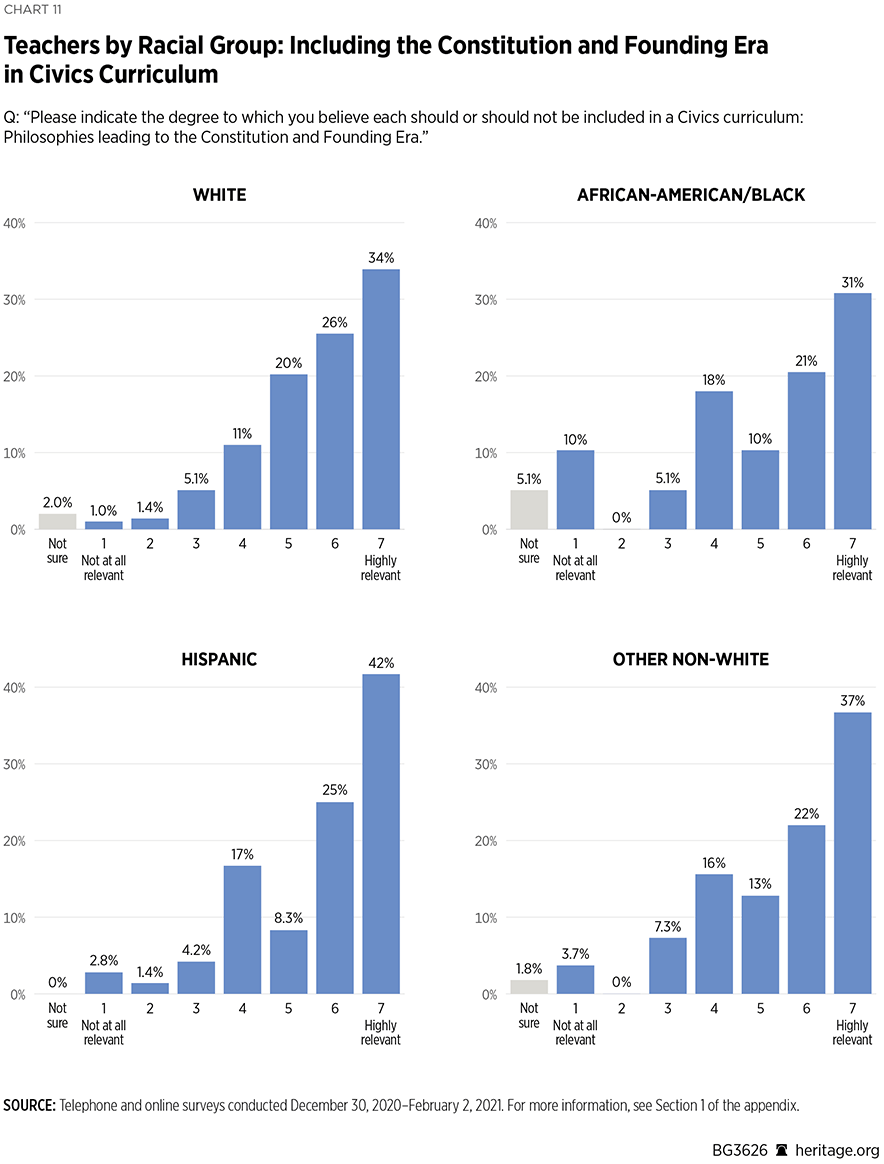
School Choice. More parents and teachers are neutral or unsure about school choice than those who support it: before the term is defined to them, 40.3 percent of parents and 38.0 percent of teachers support school choice, and 51.3 percent of parents and 43.8 percent of teachers are either neutral or unsure. Among parents and teachers alike, men were more likely than women to support it, by almost 20 percentage points. Parents of public school students were least likely to support it (36.3 percent), and parents of private school students were most likely (71 percent).
When school choice was subsequently defined for parents, their support increased from 40.3 percent to 65.2 percent, and the divide between men and women decreased substantially. In addition, defining the term caused the support from parents of public school students to increase by 26.5 percentage points. Nonetheless, even when it was defined, a quarter of parents were still unsure about their opinion on school choice.
Discussion and Additional Findings
Teachers have greater familiarity with certain newer terms related to civics education than parents, but they also advocate more strongly for revisions to traditional content related to civics education. The overall “neutral” element of parents suggests that there is work to be done for parents to understand the terms commonly used to describe topics in civics education, both in traditional and progressive approaches.
Further, half of parents claimed they did not receive a civics education growing up or were not sure if they did. As parents seek greater prioritization of civics, many will be charting territory that they themselves did not experience (or do not remember experiencing) firsthand.
While the classroom is more divided, civics education is desired by parents and teachers alike. Parents, of whom only 42.2 percent said that America’s best days lie ahead (28.8 percent said those days are in the past), are indicating that there is a missing component of their children’s education.
Teachers’ prioritization of the function to “expose students to varying viewpoints about America” conflicts with parents’ desire for civics to “ensure we are a united America.”



